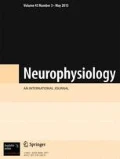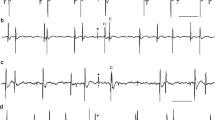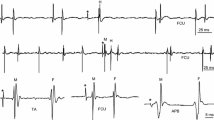Abstract
We investigated the effect of reciprocal inhibition upon single firing motoneurons of the human soleus and ex. carpus uln. A computer simulation of the effect of an inhibitory volley upon motoneuron impulse activity was carried out on the basis of our own data and data in the literature [3, 4]. It was shown that the duration of the silent period (SP), i.e., the period of complete cessation of firing as revealed on the peristimulus histogram (PSH), can be altered under the influence of the following factors: mean frequency of background firing (inverse dependence); variance of interspike intervals (ISIs) of background firing (inverse dependence); duration of that portion of an ISI of motoneuron activity during which an inhibitory volley causes a prolongation of the ISI (d); the maximum prolongation of the ISI (δxmax). If δmax<d, the duration of the SP is similar to the duration of δxmax for the briefest ISI within the range of variability in background firing. If δxmax>d, the duration of the SP is similar to the duration d of the briefest ISI. To a significant degree, the parameters of the peristimulus histogram thus determine the frequency and variance of ISIs in the background firing and possibly also the individual tendency of the motoneuron to respond to an inhibitory volley by prolongation of the ISI.
Similar content being viewed by others
Literature cited
G. A. Ivanichev, "Diagnostic value of spinal-brain stem polysynaptic reflex and period of inhibition," Zh. Nervopatol. Osikhiatr.,85, 6, 692–695 (1985).
G. V. Kozhina, "Investigation of role of reflex mechanisms in postinhibitory output with the aid of analysis of the activity of individual human motor units," Neirofiziologiya,15, 1, 78–87 (1983).
L. P. Kudina, "Investigation of reciprocal inhibition in human firing motor units," Neirofiziologiya,10, 6, 626–635 (1978).
L. P. Kudina and R. É. Pantseva, "Discovery and analysis of recurrent inhibition of human firing motoneurons," Neirofiziologiya,16, 1, 88–96 (1984).
R. S. Person and G. V. Kozhina, "Investigation of silent period with the aid of post-stimulus histograms," Neirofiziologiya,10, 1, 177–185 (1978).
U. Calvin and Ch. F. Stevens, "Synaptic noise and other sources of randomness in motoneuron spike intervals," J. Neurophysiol.,31, 2, 574–587 (1968).
E. E. Fetz and B. Gustafsson, "Relation between shapes of postsynaptic potentials and correlated changes in firing probability of cat motoneurons," J. Physiol.,341, 387–410 (1983).
H. W. Glas, J. L. F. van der Weytjens, A. De Laat, et al., "The influence of clenching-level on the post-stimulus EMG complex, including silent periods, of the masseter muscles of man," Arch. Oral Biol.,29, 1, 51–58 (1984).
H. Kranz, C. Adorjani, and G. Baumgartner, "The effect of nociceptive cutaneous stimuli on human motoneurons," Brain,96, 3, 571–590 (1973).
L. P. Kudina, "Reflex effects of muscle afferents on antagonist studied on single firing motor units in man," Electroencephalogr. Clin. Neurophysiol.,50, 1, 214–221 (1980).
L. P. Kudina and R. E. Pantseva, "Recurrent inhibition of firing motoneurons in man," Electroencephalogr. Clin. Neurophysiol.,69, 2, 179–185 (1988).
G. Midroni and P. Ashby, "How synaptic noise may affect cross-correlations," J. Neurosci. Meth.,27, 1, 1–12 (1989).
T. S. Miles, T. H. Le, and K. S. Türker, "Biphasic inhibitory responses and their IPSPs evoked by tibial nerve stimulation in human soleus motor neurons," Exp. Brain Res.,77, 3, 637–645 (1989).
R. S. Person and G. V. Kozhina, "Study of orthodromic and antidromic effects of nerve stimulation on single motoneurons of human hand muscles," Electromyogr. Clin. Neurophysiol.,18, 16, 437–456 (1978).
D. Philipova, "Investigation of the human silent period," Fifth International Symposium "‘Motor Control’ 85," Abstracts, Varna, P. 106 (1985).
B. T. Shahani and R. R. Young, "Studies of the normal human silent period," New Develop. Electromyogr. Clin. Neurophysiol.,3, 589–602 (1973).
S. Struppler, "Discussion of methodology and standardization of silent period," Electromyogr. Clin. Neurophysiol.,15, 2, 169–173 (1975).
Additional information
L. A. Orbeli Institute of Biocybernetics and Biomedical Engineering PAS, Warsaw (Republic of Poland), Institute for Problems of Information Transmission, Academy of Sciences of the USSR, Moscow. Translated from Neirofiziologiya, Vol. 23, No. 4, pp. 463–471, July–August, 1991.
Rights and permissions
About this article
Cite this article
Petrkevich, M., Churikova, L.I. & Person, R.S. Effect of brief inhibitory volley upon human firing motoneurons (experiment and model). Neurophysiology 23, 341–348 (1991). https://doi.org/10.1007/BF01052567
Received:
Issue Date:
DOI: https://doi.org/10.1007/BF01052567




